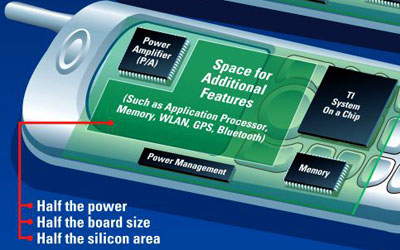
Texas Instruments announced details of a radical new approach to wireless chip design that applies digital technology to greatly simplify radio frequency (RF) processing and dramatically cut the cost and power consumption of transmitting and receiving information wirelessly. The Digital RF Processor (DRP) architecture has been successfully integrated on two Bluetooth products, as well as a GSM / GPRS digital transceiver in TI's lab.
As mobile wireless products gain color displays, cameras, GPS location technology, local area networking capability and application processors to support digital audio and video, games, and PDA applications, board space and battery life can be greatly extended by the DRP design. At the prestigious International Solid State Circuits Conference (ISSCC) this week researchers from TI are presenting details of how DRP can reduce power consumption, die area and system board space by up to 50% over traditional analog RF designs.
TI previously announced it will sample to customers this year a highly integrated, single chip GSM / GPRS product integrating the DRP design using TI's 90nm process technology. The GSM / GPRS version of the DRP architecture has already proven fully functional on engineering development silicon now in TI's lab. TI has one single chip Bluetooth product in production today with the DRP design, the BRF6100, and another sampling, the BRF6150.
The Digital RF Processor technology combines TI's years of signal processing architecture expertise with advanced semiconductor manufacturing capability to perform analog functions with low power, digital CMOS logic. Since large blocks of CMOS logic can now operate at multi-GHz frequencies, sampled-data processing techniques, switched-capacitor filters, oversampling converters, and digital signal processors can take over the role of analog amplifiers, filters, and mixers. Rather than an inefficient implementation of analog blocks in a digital process technology, with the DRP the analog signal is oversampled and processed in the digital domain. Since radio signals at the antenna are always analog, a small amount of analog processing is included in the DRP between the input and the first sampling function. Once in the sampled-data domain, digital signal processing takes over.
The RF section of a cell phone can occupy up to 50 percent of the printed circuit board, space that is required for today's advanced feature sets. Color displays, cameras, GPS location technology, Bluetooth personal area networking, and WLAN connectivity for high-speed local-area data access, as well as application processors and additional memory to support digital audio and video, games, and PDA applications, are increasingly common. In addition to reducing the number of components required to implement RF, a digital design scales readily with Moore's law and enables simple modification of key RF parameters to enhance performance through software rather than system or IC redesign.
Texas Instruments provides innovative DSP and analog technologies to meet signal processing requirements.